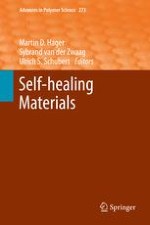2016 | OriginalPaper | Chapter
Continuum Mechanical Description of an Extrinsic and Autonomous Self-Healing Material Based on the Theory of Porous Media
Authors : Steffen Specht, Joachim Bluhm, Jörg Schröder
Published in: Self-healing Materials
Publisher: Springer International Publishing
Activate our intelligent search to find suitable subject content or patents.
Select sections of text to find matching patents with Artificial Intelligence. powered by
Select sections of text to find additional relevant content using AI-assisted search. powered by
